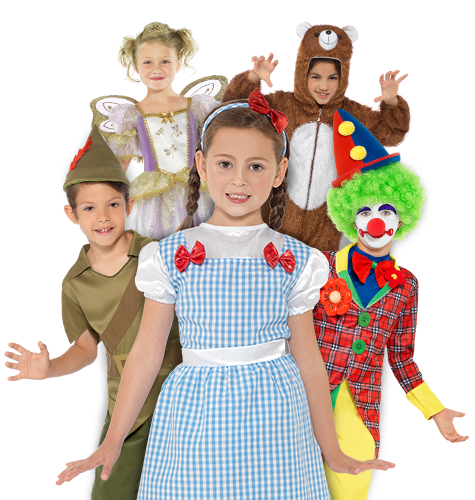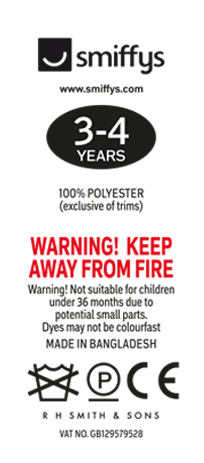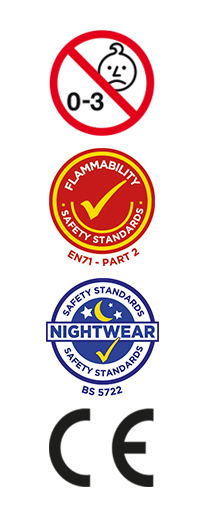Safety
Your child’s safety is our top priority
We take safety very seriously and invest heavily to ensure the integrity and safety of all our products. In 2015 alone, we invested £1,000,000 in our safety testing and procedures.

The Smiffys approach
Going above and beyond
Our dedicated in-house team ensure that all of our children’s costumes (and certain accessories) are manufactured and rigorously tested to comply with both EN71 regulations AND Nightwear (Safety) Standards. This ensures the absolute highest safety standards and reassurance that our children’s costumes are safe and fit for purpose.
We take pride that all Smiffys children’s costumes are:
- Labelled "Warning. Keep away from fire" irrespective of the burn rate within the EN71 regulatory limit
- Labelled with the CE mark as a declaration that the product meets the European Toy Safety Directive (2009/48/EC), and has undergone a variety of product tests to ensure that it is safe for use
- Tested to Nightwear (Safety) Standards as an additional safety measure
- Every product line is quality controlled throughout development and at production stage. Additional spot checks are performed as a surveillance measure, to ensure that the highest safety standards are maintained.
Every production run is batch tested and verified as compliant at source and our safety certificates are continually updated. Costumes are therefore subject to safety checks before, during and after production. Click here to view which standards our costumes have been tested to. You can search the PDF by product name or SKU using Ctrl + F.

Be in the know
Regulations of children’s costumes
Children's costumes are regulated and must comply with EN71. This is a Europe-wide standard which tests for flammability, choking and strangulation hazards, as well as toxicity. This strict criteria does not apply to everyday children's clothing (with the exception of some nightwear).
- Children's clothing can catch fire and burn when exposed to fire and naked flames, and some manufacturers only voluntarily add 'Keep away from fire' warnings.
- Children's costumes must comply with EN71 Toy Directive. This is a Europe-wide standard which tests for small parts and sharp edges (choking and strangulation prevention), flammability and toxicity.
- The flammability testing for EN71 measures the 'rate of flame spread' on fabric and complete costumes, and how quickly the flame extinguishes.
Suppliers can voluntarily test children’s costumes to Nightwear (Safety) Standards, and Smiffys does this as an additional measure to EN71.
Fake Britain Investigates
We were pleased that all our hard work paid off when Fake Britain highlighted the importance of safety in children’s costumes. It’s so important for consumers to know what they are buying and why they should value the genuine Smiffys product. It really does make a difference. Watch and you'll see (from 8 mins 11 seconds).
Dominique Peckett, Director, commented:
"We're delighted to see the airing of the Fake Britain episode. We've been working hard to highlight the issues surrounding counterfeit products, particularly, to our trade customers and consumers alike and the potential safety risk. We're grateful that Fake Britain has given us the opportunity to explain to consumers the risks and how they can best protect themselves.
We are now voluntarily testing all of our children's costumes to the most stringent flammability standards, the Nightwear regulations, whilst supporting the work being done on the proposed "extended" EN71 regulations. It's important that all of our customers have the information to make an informed choice when buying dress-up costumes and fancy dress and we always hope they value the quality and investment we make in ensuring we provide a fantastic range with fun and safety in mind."

Be aware
Making informed choices with children’s costumes
Other manufacturers may not be as vigilant about safety as we are. By cutting corners to save cost; they may not be prepared to invest in safety procedures and testing standards.
What to look for
Safety checks for parents
- The packaging, or any accompanying leaflet, should contain specific parental or flammability warnings, safety symbols and instructions for use, etc
- Costumes should be permanently labelled with the CE mark and relevant fire warnings
- Check the CE marking hasn't been faked, check the correct logo has been used, particularly the middle line of the E as it should be shorter
- The label or packaging should contain the manufacturers name, address, postcode or phone number and a registered trademark
Don't be deceived by cheap, counterfeit Smiffys branded products, online or in-store. These items will not have undergone the rigorous safety checks or stand up to the safety standards Smiffys employs as a responsible manufacturer.
Watch out
Beware of counterfeits
We invest time and money removing counterfeit products and work closely with online marketplaces to remove infringing product listings and fake replicas. We take legal action where we identify illegal sellers copying our 'branded' designs and products.
Not only are customers who buy counterfeit costumes disappointed by the quality and unable to return them, but these products are potentially unsafe. Selling counterfeit goods is illegal and usually funds criminal activities. Make sure you only purchase through authorised re-sellers of Smiffys or on Smiffys.com. If you’re not sure, ask us. That way you can assure your family’s safety.
As a family run business we understand the needs of parents to feel confident in the costume they choose for their children. We pride ourselves in going above and beyond the safety regulation requirements to provide a costume that we can both feel confident putting our children in for Halloween and any dress up occasion.
Safety FAQs
1. What are the legal obligations for testing fancy dress costumes?
Fancy dress costumes are categorised as toys and therefore must comply with the European Toy Safety Directive EN71 parts 1, 2 and 3. This means that in the UK, all costumes Age 14 and under, must meet strict criteria with regards to testing and labelling.
Costumes are tested to make sure that they do not pose a choking or strangulation risk. They are also tested to additional flammability tests over and above EN71. Plus individual fabrics and components are tested for toxicity, to make sure we manufacture a safe and fit for purpose costume.
2. What does the flammability test involve?
A specific flame is applied to both fabric and samples as a complete costume, to test the rate of flame-spread and any self-extinguishing properties - in other words, how quickly the fabric burns in (s)/mm and how quickly the flame goes out by itself, if ignited and self-extinguished.
The rate of spread of flame of the test sample should not exceed 30 mm/or the test sample shall self-extinguish. If the rate of spread of flame is between 10 mm/s and 30 mm/s, the appropriate part(s) of the toy and the packaging shall be permanently marked with the following warning: "Warning. Keep away from fire"
3. What steps are taken to ensure the legal safety standards are met on all Smiffys costumes?
Working in partnership with our preferred global Test House - Intertek, Smiffys follow a strict due diligence process to ensure that all our products are rigorously tested before they reach the market. Every product line is batch tested at production stage and on arrival in to the UK. Then additional spot checks are performed as a surveillance measure, to ensure that the highest safety standards are maintained.
4. What should I look for on the label?
Smiffys products carry a CE mark to show that they comply with the legal standards set out in EN71. Smiffys costumes are also labelled with a 'Warning, Keep Away From Fire'.
5. What are the legal safety-testing requirements for Nightwear?
In the UK and Europe, nightdresses, pyjamas, dressing gowns, bath robes and similar garments must comply with the Nightwear (Safety) Regulations standards BS5722. Smiffys are applying this test method to all our Children's Costumes for Age 14 and under, as an additional flammability measure.
6. What does the Nightwear (Safety) Standards flammability test involve?
Six pieces of the same garment, including threads, trimmings and decorations (prints/components) are tested. All samples must be washed/conditioned prior to testing. The garment is hung in a vertical frame and a flame is applied to the bottom two inches for ten seconds. The time it takes for the flame to spread to a 'trip thread' must not exceed 25s/300mm and subsequently 50s/600mm.
7. What are the main differences between EN71 and the Nightwear (Safety) Regulations?
EN71 has a broader remit and requires that testing criteria on a wider range of safety issues is adhered to, for example small parts / heavy metal content of the fabric. In many respects, the testing process for EN71 is more rigorous and further criteria must be met in order to comply. It is possible for a garment to comply with the Nightwear Regulations if the fabric melts or chars when set alight, which may be more dangerous to a child than an EN71-compliant, self-extinguishing fabric.
8. What does Smiffys new safety policy on all new lines in the 2016 collection mean for me as a consumer?
From January 2016, all Smiffys children's costumes are tested to meet BOTH EN71 & Nightwear standards, in order to ensure the absolute highest safety standards and provide reassurance that all children?s costumes are as safe and fit for purpose.
Building on the strict safety testing standards already in place, Intertek will continue to test Smiffys costumes to EN71 standards and additional Nightwear (Safety) Regulations standards testing has been introduced at source.
Click here to continue shopping at Smiffystrade.com.au


